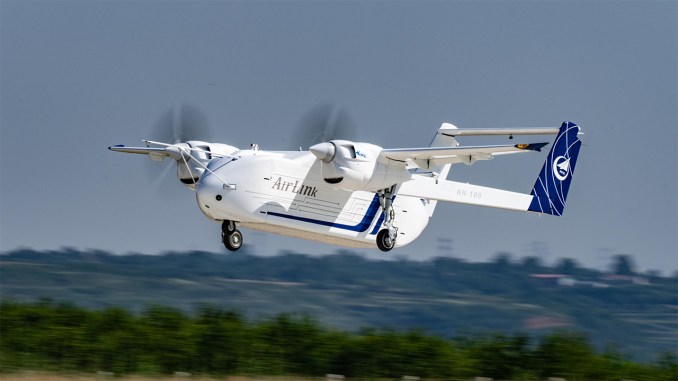
On Apr. 3, 2024 the unmanned aircraft was announced ready for its maiden flight, after it performed a “final high-speed taxi trial”.
China’s HH-100 unmanned transport aircraft flew its maiden flight on Jun. 12. 2024 in the country’s northwestern Shaanxi Province. Developed by X’ian Commercial Aircraft Co., a part of AVIC (Aviation Industry Corporation of China), the UAV has been described as a “demonstrator” version of the aircraft, suggesting future development and serial production, based on the test results and user requirements.
Leading Chinese military aviation researcher Andreas Rupprecht posted pictures on X, of the drone operating from the runway. According to Xinhua, the “commercial unmanned transportation system’s successful maiden flight” took place at a general aviation airport. The twin-engine, high-wing, high-tail boom configuration UAV has a large bulbous middle section fuselage, presumably to accommodate cargo, with the space afforded by the absence of a manned crew.
The “low-cost and high payload” aircraft has a maximum take-off weight of 2,000-kilograms, can carry 700-kg of cargo to a distance of 520-km at full weight, clock a maximum speed of 300-km an hour and touch a altitude of 5,000-meters according to AVIC. The test validated the “stable performance” and met the “test-flight requirements” of all major systems, where the aircraft itself, airframe, the “ground-based command-and-control station…(worked) well.”
It was announced on Apr. 3 that the aircraft was ready for its first flight, after it performed its “final high-speed taxi trial” on that day, CGTN reported. The HH-100 successfully undertook “rotation” – lifting its nose wheel at take-off speed. It demonstrated “stable performance and precise autonomous taxiing control,” thereby “(clearing itself) for its maiden flight.”
Today, the AVIC HH-100 transport UAV successfully completed its maiden flight in Shaanxi.
(Images via @航空工业 & @沉默的山羊 from Weibo) pic.twitter.com/9kuBRPbSf7
— @Rupprecht_A (@RupprechtDeino) June 12, 2024
Still in Development Stage, More Tests Likely
The drone has a wide array of civilian applications including primarily emergency-oriented roles. “These include feeder logistics, fire suppression in forests and grasslands, fire monitoring, transportation and delivery of emergency supplies, communication relay, and even artificial rain enhancement,” CGTN said, quoting company officials. The drone has the “distinction of being entirely built using domestically sourced components.”
The photos on social media and Chinese reports showed an air data probe/pitot tube still attached to the nose, meaning the aircraft is likely to remain in the testing phase for some time. It is not clear whether the maiden flight involved the HH-100 flying with a mock payload, although it’s quite likely the test flight merely involved determining its elementary flying, flight systems and remote operation. According to China Daily, the HH-100 “took off at 9:16 am, and landed steadily after a 35 km-flight.”
China’s homegrown HH-100 unmanned cargo aircraft completed its maiden flight test in northwestern province of Shaanxi on Wednesday, according to the Aviation Industry Corporation of China (AVIC). https://t.co/BRvOwxbhIh pic.twitter.com/9o6WyLgcoS
— CCTV+ (@CCTV_Plus) June 12, 2024
After future trials cover these areas, a final configuration prototype would likely be displayed, before entering limited series production and then pitched to potential customers. The developer fielding variants with differing types of control and navigation system, based on customer needs, is also possible.
Generally speaking, for systems like this, subsequent tests are likely with payload simulating carriage at different distances, altitudes, with a final journey between two points at its maximum range. The degree of autonomy also seems limited to taxiing. Whether this extends to autonomous take-off, landing and navigation between two set waypoints, is not clear.
The pictures also showed the landing gear to have remained extended. It is unlikely to be a fixed tricycle landing gear. This is because the section’s design appears complete with either a hydraulic or a pneumatic suspension system that possibly folds into the rear section of the engine. The side of the chin meanwhile shows two round sensors, which could possibly be basic fixed electro-optical CCD cameras capturing the ground for landing and take-off.
Not AVIC’s First Unmanned Transport Aircraft
This is also not AVIC’s or China’s first unmanned cargo aircraft. Jun. 18, 2022, saw the AVIC’s TP500, the country’s first large uncrewed plane produced as per CCAR (Chinese Civil Aviation Regulation) requirements, undertake its maiden flight. The 27-minute flight took place in Jingmen city, in central China’s Hubei province.
The low-wing front propeller UAV, that looks like a regular monoplane aircraft, can carry the standard 500-kilogram load to 500-km according to AVIC. “The plane is a general-purpose unmanned transport platform with a large load and a maximum range of 1,800-km,” said AVIC.
The larger range presumably is the distance without any payload. Reports also said that in addition to freight-handling roles, the AVIC envisions a broad set of missions for the TP500, including SAR (Search and Rescue), airborne communications relay, and remote sensing mapping.
- SEO Powered Content & PR Distribution. Get Amplified Today.
- PlatoData.Network Vertical Generative Ai. Empower Yourself. Access Here.
- PlatoAiStream. Web3 Intelligence. Knowledge Amplified. Access Here.
- PlatoESG. Carbon, CleanTech, Energy, Environment, Solar, Waste Management. Access Here.
- PlatoHealth. Biotech and Clinical Trials Intelligence. Access Here.
- Source: https://theaviationist.com/2024/06/12/chinas-hh-100-unmanned-transport-aircraft-undertakes-first-flight/




